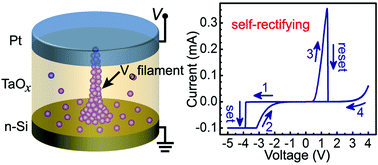Forming-free and self-rectifying resistive switching of the simple Pt/TaOx/n-Si structure for access device-free high-density memory application†
Abstract
The search for self-rectifying resistive memories has aroused great attention due to their potential in high-density memory applications without additional access devices. Here we report the forming-free and self-rectifying bipolar resistive switching behavior of a simple Pt/TaOx/n-Si tri-layer structure. The forming-free phenomenon is attributed to the generation of a large amount of oxygen vacancies, in a TaOx region that is in close proximity to the TaOx/n-Si interface, via out-diffusion of oxygen ions from TaOx to n-Si. A maximum rectification ratio of ∼6 × 102 is obtained when the Pt/TaOx/n-Si devices stay in a low resistance state, which originates from the existence of a Schottky barrier between the formed oxygen vacancy filament and the n-Si electrode. More importantly, numerical simulation reveals that the self-rectifying behavior itself can guarantee a maximum crossbar size of 212 × 212 (∼44 kbit) on the premise of 10% read margin. Moreover, satisfactory switching uniformity and retention performance are observed based on this simple tri-layer structure. All of these results demonstrate the great potential of this simple Pt/TaOx/n-Si tri-layer structure for access device-free high-density memory applications.


 Please wait while we load your content...
Please wait while we load your content...